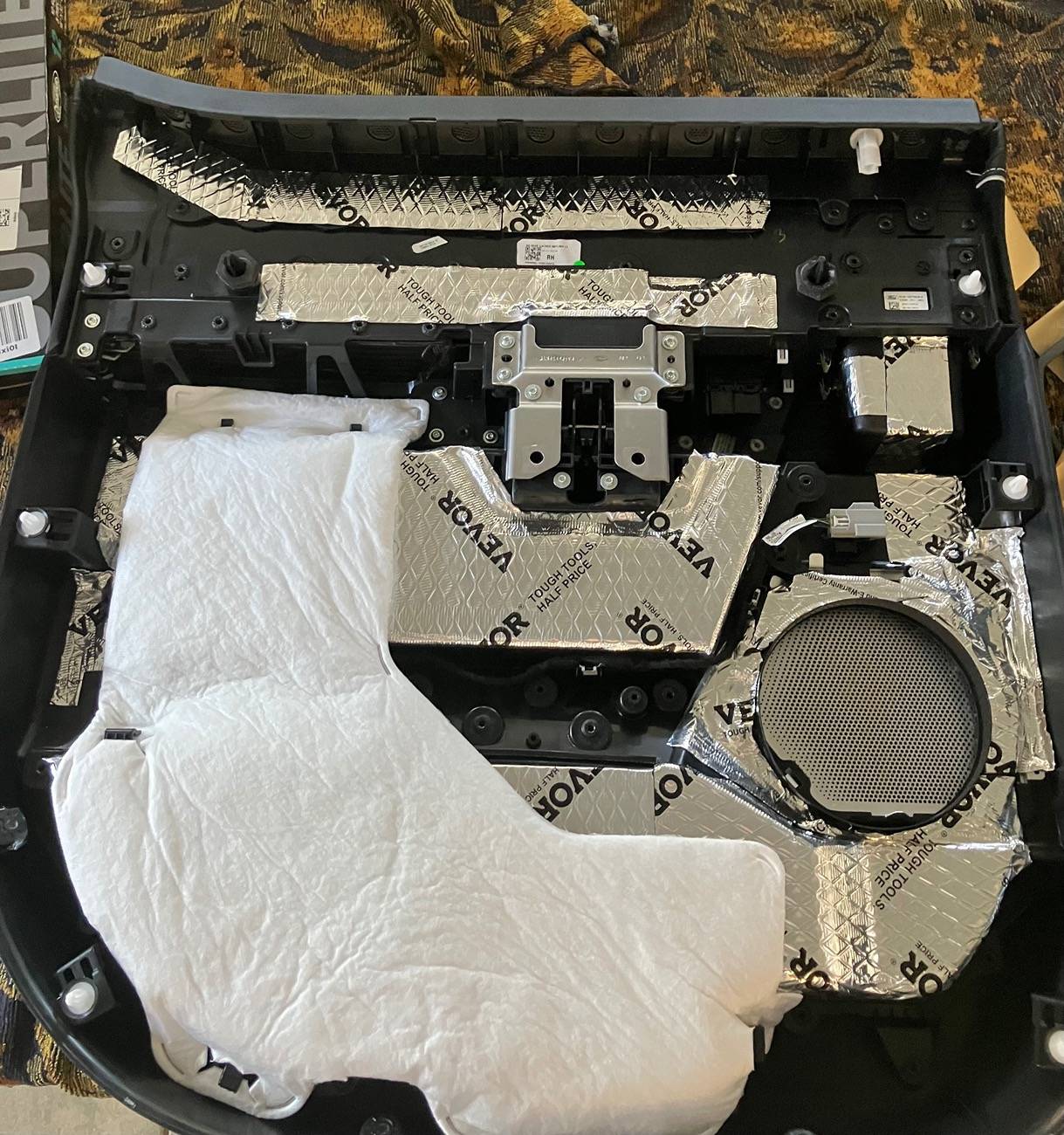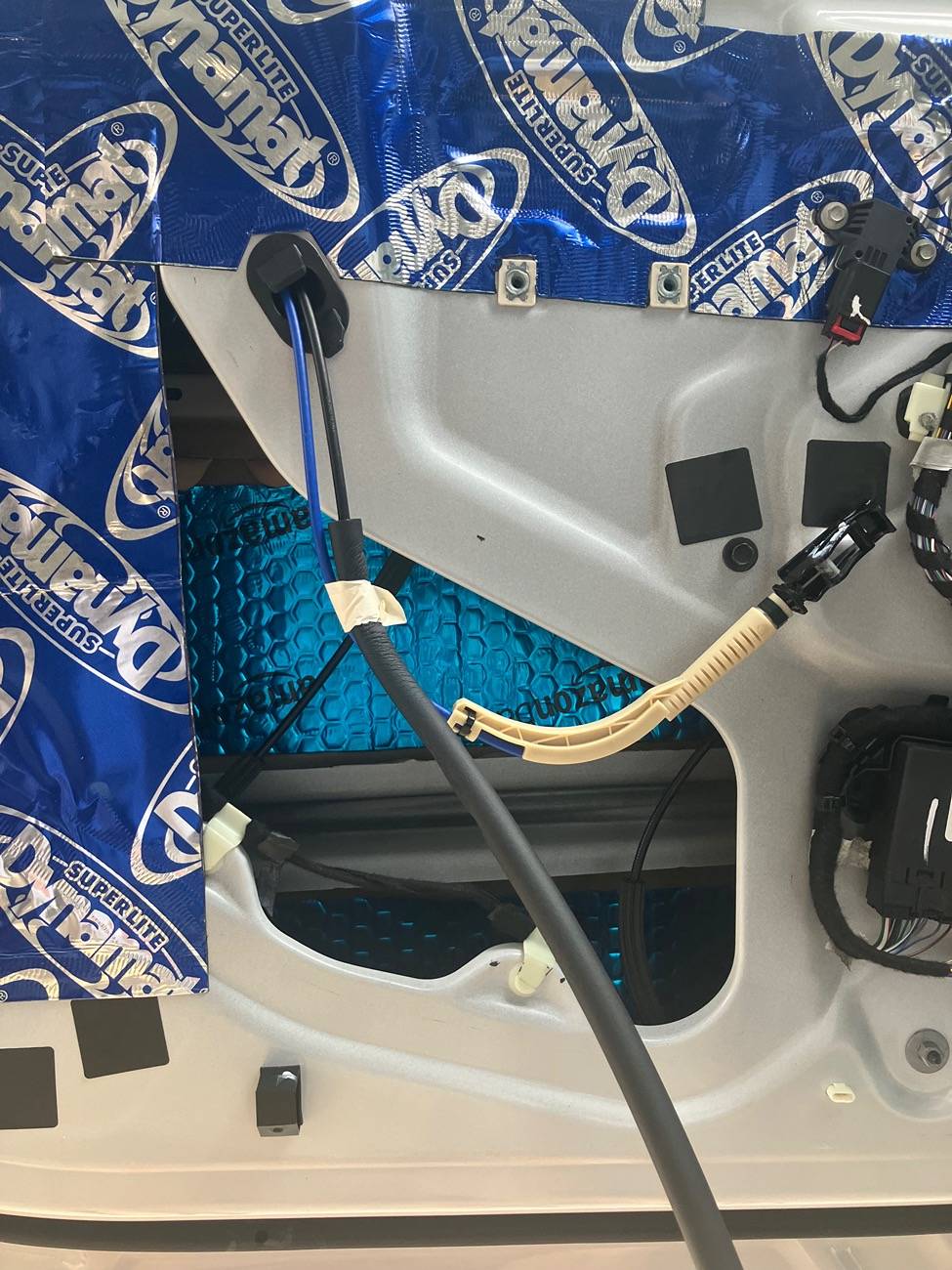Ben21
Member
- First Name
- Ben
- Joined
- Dec 15, 2024
- Threads
- 3
- Messages
- 20
- Reaction score
- 47
- Location
- NW Arkansas
- Vehicles
- Ford F-150 Lightning Pro SR
- Thread starter
- #1
This is a write up on my experiences modifying the insulation on my f150 lightning to improve audio quality and cabin temps.
If you're interested in ways to quiet the cabin and reduce heat/cooling losses, read on. I'm curious about any questions or thoughts on this and happy to expand on any points covered. This equally benefits F150 owners, but they won't benefit from the thermal management benefits that are more important to the Lightning version.
I split it up into background, Ford setup, my goals, process, and lastly with Extra ideas.
Background:
It can be hard to hold a conversation in the truck at highway speeds, especially with any accessories on the vehicle.
I was inspired by someone with an f150 owner on YouTube with a roof rack who improved the sound deadening in between the roofliner and the roof. They installed an amazon sticky butyl rubber mat (ones lined with metal) behind the headliner on the metal of the roof and found a lot of improvement. This material can reduce vibrations and thus sounds.
However, after my implementing it on my own, I found that there are some better ways to quiet the cabin, especially on the highway. The butyl bladder rubber approach is not what high-end luxury cars do. So, I looked at some tear downs of various luxury cars like Mercedes EQS, Lexus LS, RVs, and other luxury cars to grasp what automakers do for soundproofing (examples: under the wheel wells to inside the cabin, to the new version of the model 3's soundproofing, extra door seals, role of foam and various materials, etc)
Ford's Soundproofing background
Ford did a good job with soundproofing (think acoustic glass, underwheel liners, etc, uniform insulation that balances weight and performance.). The Lariats and Platinum trims have a bit better soundproofing, but would still benefit from some fixesthis based what I've seen. The Lightning has more advancements than the regular F150s in terms of sound management, but not as much as they could have done since it is based on the F-150 part production. A lot of the aerodynamic enhancements conveniently help the sound management, but they left some things on the table, like with the mirror and parts of the side profile. As a sidenote, the Hummer EV uniquely suffers from sound issues due to those plastic open roof panels, so those owners may also benefit from the solutions here.
All cars ultimately skimp on soundproofing due to cost, weight, installation difficulty, and safety/efficiency reasons. And for EV's they might even want the cabin to be loud, so you don't drive too fast, as wind noise can signal you to slow down and extend your range. Personally I enjoy the comfort of that independent rear suspension cruising at 80mph in a quiet cabin. It's hard to explain but the vehicle feels more like a rock. I experimented with this and tried to give a balanced approach here. One part is by using thinsulate, a synthetic cotton like material. Another part is using butyl rubber sticky mats.
My Goals:

I was really most interested in music. The music plays would play better inside, and less of it can be heard outside That's what got me started on it anyways. since I was taking off the door panel to replace the speakers, I might as well make other sound deadening changes.
Process:
I'd suggest going with Thinsulate first, then butyl rubber mats. Thinsulate is safer for your skin, more effective, and offers thermal benefits.
- Safety-wise, Thinsulate is the industry-leading material and should not worry you. Just be careful not to cover airbags.
- It takes around two hours, especially convenient for those already considering swapping the speakers since you can do it in one go.
- Remember how I said thinsulate could manage the heat of the sun in the summer from entering through the roof? I have no idea about the consequences of this on the paint. If less warmth is let transfer into the cabin, it could cause the heat on the meat to go higher than it would have otherwise been. I think it should be fine, especially if you put a polish on the paint, but I am worried that my black paint will deteriorate faster because it will be hotter on the surface during the summer.
This method can significantly reduce cabin noise and improve thermal insulation. However, I haven't taken enough measurements to tell you exactly how much. All I know if that I've looked at how the Lincolns and luxury makes do it, and looked to copy that. I look forward to real world testing this winter and summer months to see the effect. Happy to answer any questions.
If you're interested in ways to quiet the cabin and reduce heat/cooling losses, read on. I'm curious about any questions or thoughts on this and happy to expand on any points covered. This equally benefits F150 owners, but they won't benefit from the thermal management benefits that are more important to the Lightning version.
I split it up into background, Ford setup, my goals, process, and lastly with Extra ideas.
Background:
It can be hard to hold a conversation in the truck at highway speeds, especially with any accessories on the vehicle.
I was inspired by someone with an f150 owner on YouTube with a roof rack who improved the sound deadening in between the roofliner and the roof. They installed an amazon sticky butyl rubber mat (ones lined with metal) behind the headliner on the metal of the roof and found a lot of improvement. This material can reduce vibrations and thus sounds.
However, after my implementing it on my own, I found that there are some better ways to quiet the cabin, especially on the highway. The butyl bladder rubber approach is not what high-end luxury cars do. So, I looked at some tear downs of various luxury cars like Mercedes EQS, Lexus LS, RVs, and other luxury cars to grasp what automakers do for soundproofing (examples: under the wheel wells to inside the cabin, to the new version of the model 3's soundproofing, extra door seals, role of foam and various materials, etc)
Ford's Soundproofing background
Ford did a good job with soundproofing (think acoustic glass, underwheel liners, etc, uniform insulation that balances weight and performance.). The Lariats and Platinum trims have a bit better soundproofing, but would still benefit from some fixesthis based what I've seen. The Lightning has more advancements than the regular F150s in terms of sound management, but not as much as they could have done since it is based on the F-150 part production. A lot of the aerodynamic enhancements conveniently help the sound management, but they left some things on the table, like with the mirror and parts of the side profile. As a sidenote, the Hummer EV uniquely suffers from sound issues due to those plastic open roof panels, so those owners may also benefit from the solutions here.
All cars ultimately skimp on soundproofing due to cost, weight, installation difficulty, and safety/efficiency reasons. And for EV's they might even want the cabin to be loud, so you don't drive too fast, as wind noise can signal you to slow down and extend your range. Personally I enjoy the comfort of that independent rear suspension cruising at 80mph in a quiet cabin. It's hard to explain but the vehicle feels more like a rock. I experimented with this and tried to give a balanced approach here. One part is by using thinsulate, a synthetic cotton like material. Another part is using butyl rubber sticky mats.
My Goals:
- Better acoustics for conversations and music
- Improved thermal insulation
- Enhanced safety and door integrity (better door thunk effect)

I was really most interested in music. The music plays would play better inside, and less of it can be heard outside That's what got me started on it anyways. since I was taking off the door panel to replace the speakers, I might as well make other sound deadening changes.
Process:
I'd suggest going with Thinsulate first, then butyl rubber mats. Thinsulate is safer for your skin, more effective, and offers thermal benefits.
- 3M Thinsulate: This is a great material. It insulates your car, reducing energy usage in winter and summer. An RV site online sells this insulation material for a good price. You can buy SM200L and line the front doors with an extra layer. Hot glue is your friend here. You can also buy SM600L and do the headliner. Important: Do not remove the headliner from the car. Instead, drop the headliner and slip in the SM400 or SM600 materials between the headliner and roof. There's no need to tie it down; it will stay in place. Honestly, you could probably just tuck and sneak in thinsulate into the headliner from the side in large sheet cuts. It's hold there and do a lot I'm sure. Especially against the heat of the sun in the summer. Costs is less than $70.
- Butyl Rubber Mats: This traditional soundproofing approach helps with vibrations and improves sound quality, giving your doors a thunk when closed. However, it's very heavy and may make doors harder to open or cause injury if they forcibly close in strong wind. I recommend about 20% coverage, especially in areas prone to vibrations. You'll need a large pair of scissors to cut the panels to shape. The material can easily cut your hands, so wear heavy-duty gloves. Cost of is less than $50.
- There's no sense in applying material to the floors. There's a huge battery there providing insulation and some moving pad like sound blankets between the carpets and the floor
- Many cars have more soundproofing in the wheel wells than the f150 lightning features, even though Ford deserves credit for putting good wheel wells on the lightning when they really didn't need to do that. Adding more materials in the same places where the existing material could be beneficial because it would be thicker and reduce road noise.
- I would re-inspect the added materials after a few years to ensure they are still in good condition, especially if placed in exterior areas. Or don't, that's fine too.
- Safety-wise, Thinsulate is the industry-leading material and should not worry you. Just be careful not to cover airbags.
- It takes around two hours, especially convenient for those already considering swapping the speakers since you can do it in one go.
- Remember how I said thinsulate could manage the heat of the sun in the summer from entering through the roof? I have no idea about the consequences of this on the paint. If less warmth is let transfer into the cabin, it could cause the heat on the meat to go higher than it would have otherwise been. I think it should be fine, especially if you put a polish on the paint, but I am worried that my black paint will deteriorate faster because it will be hotter on the surface during the summer.
This method can significantly reduce cabin noise and improve thermal insulation. However, I haven't taken enough measurements to tell you exactly how much. All I know if that I've looked at how the Lincolns and luxury makes do it, and looked to copy that. I look forward to real world testing this winter and summer months to see the effect. Happy to answer any questions.
Sponsored
Last edited:



